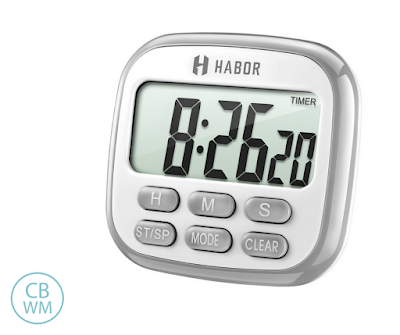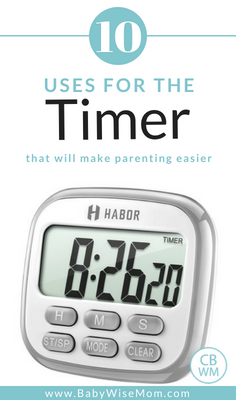Uses For a Timer That Will Make Parenting Easier. Tips for making discipline, chores, reading, and technology tracking easier.

A highly underutilized tool in parenting is the simple timer. The timer can help you with discipline, teaching manners, chores, reading minutes, independent playtime implementation, and tracking video game or television time. Basically any time your child doesn’t want to do something or wants to do something too much, the timer is your friend. Here are my favorite ways to use the timer (affiliate link) to make parenting a little easier.
Post Contents
Uses for the Timer as a Parenting Tool
Time Out
Sometimes your child just needs a break from people or the situation. When that happens, you might decide to use a time out for that child. A timer is a handy tool during a time out. Set the timer and leave it in the room with the child. Tell your child she can get out when the timer goes off. Then the child learns his/her crying doesn’t decide when the time-out ends; the time spent decides.
Setting a timer lets your child realize that a certain amount of time needs to pass before he can move on to the next task. In this case, your child knows that he must sit in time out until the timer goes off. Him whining and crying will not get him out; the timer going off decides.
As my children get a little older, I take this up a level. I will set the timer only after the child is calmed down. Then he/she needs to sit calmly for a couple of minutes before rejoining the family. Read my detailed post on Time-Out/Isolation for my full tips on using this method for discipline.
I do have a word of caution here. You don’t want your child to think that all he has to do is go sit in a room by himself for a few minutes and then he can go on his way. If your child starts to view time out as something that is no big deal, try to find another method of punishment that will be effective for him. The timer can act as your minimum, but you don’t want your child to perceive that the timer rules you. Mom always decides.
Whining
Whining can be as tolerable as nails on the chalk-board. All children go through at least one whining phase as they grow up. Some kick it faster than others. When you find yourself in the thick of it, break out the timer to break this habit if needed. When your child whines, say, “Oh! Looks like you need a minute to think of how to say that in a better way. I will set the timer and you can try again.” While the timer is going, you child is not allowed to talk. Again, the timer helps your child understand that whining does not lead to your child getting his/her way. For more help on whining, see:
Impolite Behavior
My children have all gone through a phase when they would just say, “More” or “More cheese” during a meal. They forget their manners. Initially, we will remind them, “How do you ask?” and they will add the “please.” That gets frustrating after a while. The child demands, I ask how they should really ask, the child adds a “please” and then the child gets what she wanted. There isn’t much motivation to ask nicely in the first place.
At that point, I have always said, “Oh dear. I will set the timer and you can try asking in a polite way.” I will then set the timer for two minutes. After the timer goes off, the child can try asking again in a polite way. This way the child actually has some delayed gratification and will actually put some effort into using manners the first time.
This same concept can be used for interrupting or any other impolite behavior.
I will illustrate with a story from our life.
Brayden has always been very good about saying thank you, even from a young age. “Thank You” was one of his first words. I, however, did not do well with training him to say please. I realized this folly somewhere around 18 months old, which proved to be late enough that the word “please,” and all that it implies, is something we revisit over and over again. Incidentally, I did not repeat this mistake with Kaitlyn and she is quite good about asking nicely.
Brayden had gotten to be good about saying please sometime as a three year old. At some point, I increased my expectations. I didn’t just want the phrase, “More milk please” tossed my way. I instructed Brayden to say, “Mommy, may I please have some more milk.” I taught him to use a kind and patient tone.
This worked well, but every so often, we found ourselves in need of retraining. At first, I would remind Brayden to ask nicely. I would ask him how he should ask nicely. As he turned four, I decided we needed to fix this problem. For that, I turned to my trusted timer.
Whenever Brayden asked for something without saying it in a nice way, I would set the timer and tell him when the timer went off, he could try asking again. Before, he had no real motivation to ask nicely. He asked. I reminded. He asked nicely. He received.
But with the timer thrown in there, there was a definite downside to not asking nicely. He asked. I set the timer. It ticked down. It went off. He asked nicely. He received.
There was a delay in his reward. I only had to set the timer two times before he started consistently asking nicely.
Chores
You can use a timer in a lot of ways for chores. You can tell your child you are going to time her and see how long it takes her to get a chore done. That can be very motivating for some children.
You can also set a timer and say the chore needs to be done before it goes off.
Something that works well with McKenna (age 9) is to ask her how long a task will take, set the timer for that long, and she sees if she can get it done in that time. She is always faster than the timer. She likes the challenge, and it is a great way to motivate her to stay focused. She is a dreamer and can easily get distracted in her world of imagination when doing her chores. The timer helps her stay focused.
Technology
It can be very easy to let time spent with technology run away with out you. You can use a timer to set it to go off when technology time is over. This is especially useful for something like video game time. We are using timers this summer to keep track of video game time and make sure we don’t go over on the time spent.
Reading Time
The timer can be handy in many ways when it comes to reading. You use it if your child doesn’t love to read. You set the timer and tell your child to read until it goes off.
My children have the opposite problem and will read much too long (this is really just a problem at night). This is especially true for McKenna. She gets very lost in her books and it can be 10 PM before she even realizes it. We got a timer for her so it can pull her from her book. Once it goes off, she knows it is time for lights out.
This is also a handy tool if you are doing any Sustained Silent Reading. Your children can know they read until the timer goes off and don’t ask how much longer over and over.

Practice Time
If your child needs to do any practicing of any sort, the timer is a great tool for that. Set the timer and your child practices until it goes off.
10 Minute Cleaning
I love a good 10 minute cleaning. I clean as much as I can for ten minutes. You will be amazed at how much you can get picked up when you are focused in for ten minutes! The timer works for you and your children on this one.
Couch Time
Couch time is a great tool for helping to strengthen marriage and show your children you value your marriage. The timer can be helpful for your children to know how long they need to be quiet and respectful of the time you are spending together. It helps them get used to the length of time they are not allowed to interrupt.
Quiet Practice
When my preschoolers need to learn how to hold still and stay quiet, I do what I call “reverent practice.” They sit on a chair and fold their arms or clasp their hands together. The rule is they have to stay still on the chair without talking for two minutes. I set the timer. If they talk or get off the chair, I reset the timer to two minutes. If they move around on the chair a lot, I reset the timer. They have to sit still and quiet for two consecutive minutes before they can get down. It doesn’t take long for them to learn to sit still and quietly for the two minutes. They can then transfer that skill over at church, the doctors office, or wherever else I need them to be still and reverent.
Bonus Tip: Independent Playtime
When you are working to have independent playtime with your child, the timer can be a great help. Set the timer for whatever length of time you are aiming for. Keep in mind that if your child is resistant to independent play, you probably want to keep this length less than 5 minutes at first.
Leave the timer in the room with your child. Tell your child to have fun and play and you will be back once the timer goes off. Your child will soon learn that the timer, not her crying, is what decides when independent playtime is over.
As your child can play happily for five minutes, increase the time slowly. This is very effective. I have often suggested this to moms and they come back with positive reports.
Conclusion
The timer is a great tool for you to use in your day to day parenting! It gives you something to use to help your children learn proper behavior. It helps motivate and helps with delayed gratification. Give it a try!
Get your timer from Amazon (affiliate link) or places like Walmart or Target.
